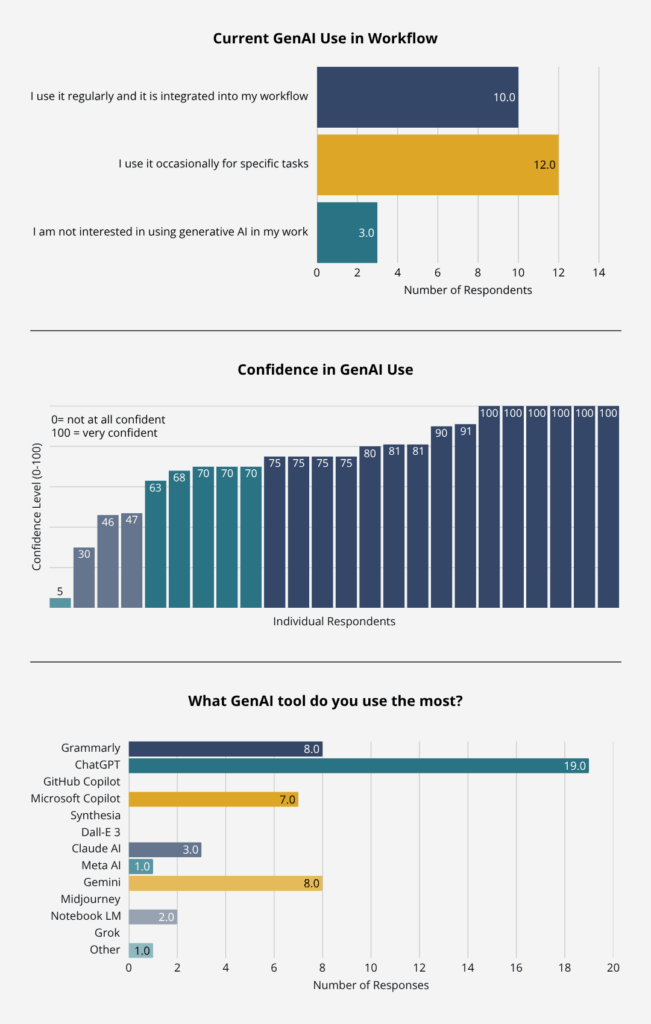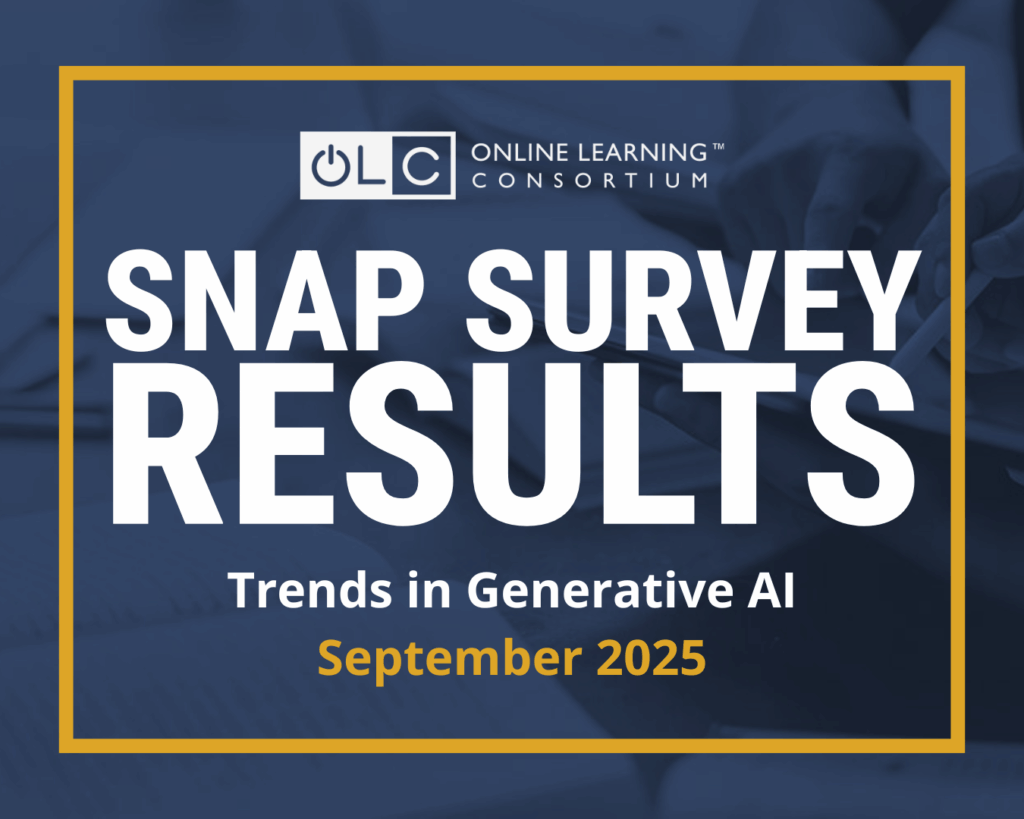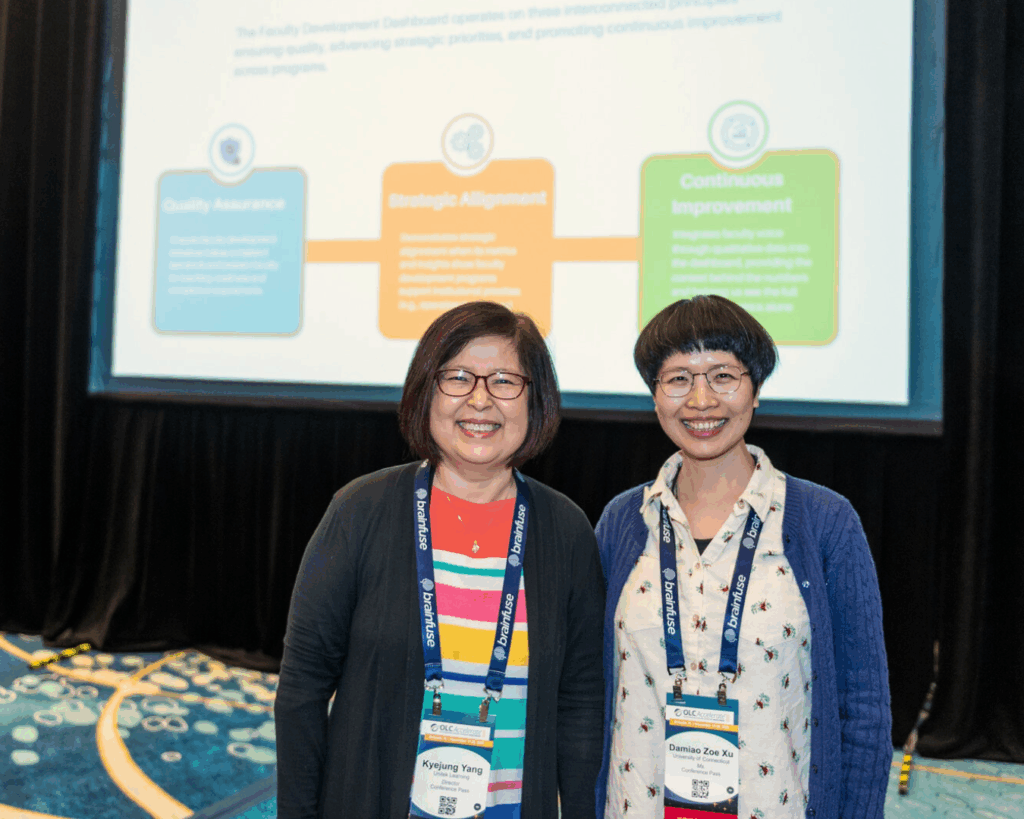The September 2025 OLC Snap Survey highlights how generative AI (GenAI) continues to shape higher education and professional practice. Three themes stand out: respondents are increasingly confident in their ability to use GenAI tools, ChatGPT dominates the landscape as the tool of choice, and the community remains polarized between enthusiastic adopters, cautious experimenters, and vocal skeptics. These findings suggest that the future of AI in education will not be determined solely by adoption rates but by the confidence, criticality, and intentionality with which it is integrated into daily practice. They additionally point to the need for more nuanced faculty development, using a tiered approach that recognizes wide variance in comfort and skill levels. For practical guidance implementing such an approach, please review our evidence-based resource, the Faculty Development and GenAI Playbook.

The Confidence Gap
When asked about their confidence in using GenAI tools effectively, respondents’ (n=25) answers spanned the full spectrum from zero to one hundred. The average score was 75, indicating that most participants felt comfortable with these tools. Two respondents reported very low confidence, while six described themselves as “very confident.” Taken together, these results suggest that three years into the GenAI era, professionals across roles such as instructional design, educational technology, and faculty development are generally becoming more adept at using these technologies in their work.
How GenAI Is Used
Patterns of use, however, vary widely. A majority of respondents—just under fifty percent—reported using GenAI occasionally and typically for very specific tasks. About forty percent indicated that they use it regularly and have already integrated it into their workflows. At the same time, a smaller group, roughly twelve percent, expressed a refusal to engage with GenAI at all. Their reasons centered on ethical, environmental, and legal concerns, perspectives that remind us that the enthusiasm surrounding GenAI is not universal and that skepticism is an important element of the broader conversation.
ChatGPT’s Clear Dominance
When asked which tools they rely on most frequently, respondents overwhelmingly named ChatGPT, with eighty-two percent identifying it as their primary choice. Grammarly’s AI features were also cited, though by fewer participants—just over thirty-four percent. None of the respondents reported using GitHub Copilot, underscoring the non-developer-heavy profile of the community. These findings reveal a striking brand dominance: in practice, when educators say they are using “AI,” they are usually referring to ChatGPT. Such dominance raises important questions about monoculture, licensing, and access, as well as the risks of centering educational practice around a single corporate platform. Microsoft Copilot (30%) and Gemini (34%) were also tools on the rise, with Claude, Meta AI, and Notebook LM coming in at under ten percent use by participants. Other platforms like Grok, Midjourney, Synthesia, and Dall-E 3 were not utilized by this group.
The Polarization Problem
The survey results also underscore the polarization of the community. On one side are confident adopters who use GenAI daily and have already embedded it into their professional routines. Many others fall into the middle, experimenting occasionally but not yet feeling fully skilled or integrated. A smaller group remains resistant, uninterested in adoption and vocal about their concerns. This polarization suggests that professional development strategies must be tiered rather than uniform. Introductory sessions may help beginners build confidence, while practical workshops can assist intermediates in moving toward fuller integration. Advanced users may benefit more from dedicated spaces for experimentation and research, while skeptics require forums where their critiques and concerns can be voiced and taken seriously.
What This Means for the Future
Overall, the survey results suggest that the key question is not whether GenAI will influence education, but in what ways. While the small number of respondents limits our ability to generalize too widely, institutions may want to design support structures that respond to varying levels of confidence and openness to adoption. Training that is responsive to different stages of expertise, encouragement to experiment with multiple tools rather than relying solely on ChatGPT, and opportunities for critical dialogue around ethics, equity, and pedagogy could be essential.
Conclusion
The September 2025 Snap Survey paints a nuanced picture: generative AI is widely used, confidence is on the rise, and ChatGPT’s dominance is reshaping the landscape. At the same time, resistance rooted in ethical and social concerns ensures that skepticism remains part of the conversation. The future of GenAI in education will be defined less by how quickly the technology is adopted than by the extent to which institutions and individuals engage with it critically, inclusively, and responsibly.
 As senior researcher at OLC, Carrie designs, conducts and manages the portfolio of research projects that align with the mission, vision, and goals of the Online Learning Consortium. She brings with her over 15 years of experience as an online educator and instructional designer with a passion for research. She has peer-reviewed publications covering a variety of topics such as open educational resources, online course best practices, and game-based learning. In addition to a strong background in higher education teaching and instructional design, Carrie brings with her extensive experience in customer service and small business management. She holds a PhD in Educational Technology from Arizona State University, an MS in French from Minnesota State University, and BA in French from Arizona State University.
As senior researcher at OLC, Carrie designs, conducts and manages the portfolio of research projects that align with the mission, vision, and goals of the Online Learning Consortium. She brings with her over 15 years of experience as an online educator and instructional designer with a passion for research. She has peer-reviewed publications covering a variety of topics such as open educational resources, online course best practices, and game-based learning. In addition to a strong background in higher education teaching and instructional design, Carrie brings with her extensive experience in customer service and small business management. She holds a PhD in Educational Technology from Arizona State University, an MS in French from Minnesota State University, and BA in French from Arizona State University.





